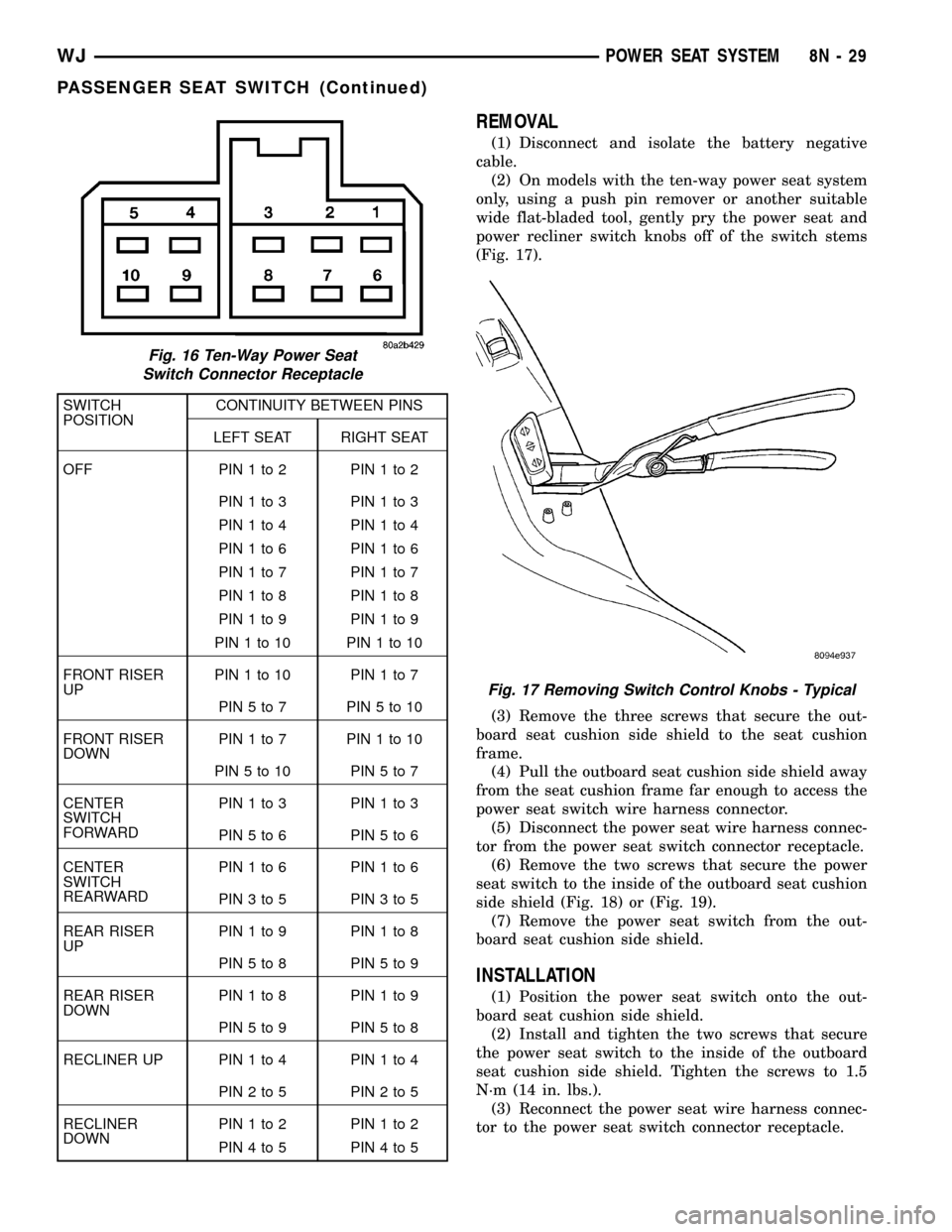frame JEEP GRAND CHEROKEE 2003 WJ / 2.G Owner's Manual
[x] Cancel search | Manufacturer: JEEP, Model Year: 2003, Model line: GRAND CHEROKEE, Model: JEEP GRAND CHEROKEE 2003 WJ / 2.GPages: 2199, PDF Size: 76.01 MB
Page 386 of 2199

HEATED SEAT SENSOR
DESCRIPTION
The heated seat temperature sensor is a Negative
Temperature Coefficient (NTC) thermistor. One tem-
perature sensor is used for each seat. This tempera-
ture sensor is located in the seat cushion heating
element on all models.
The heated seat temperature sensor cannot be
repaired or adjusted and must be replaced if defec-
tive. The heated seat cushion element must be
replaced if the temperature sensor is defective. Refer
to the procedure in this section of the service man-
ual.
DIAGNOSIS AND TESTING - HEATED SEAT
SENSOR
For complete circuit diagrams, refer toWiring
Diagrams.
(1) Disconnect the Heated Seat Module (HSM) or
Memory Heated Seat Module (MHSM) C1 connector.
Check for continuity between the SEAT SENSOR 5V
SUPPLY circuit cavity and the seat cushion frame.
There should beNOcontinuity. If OK, go to Step 2.
If not OK, repair the shorted seat sensor 5V supply
circuit as required.
(2) Check for continuity between the SEAT SEN-
SOR 5V SUPPLY circuit cavity of the 4-way power
seat wire harness connector and the C1 connector for
the HSM or MHSM. There should be continuity. If
OK, go to Step 3. If not OK, repair the open seat sen-
sor 5V supply circuit as required.
(3) Connect the module electrical connector. Turn
system ON, using a voltmeter, backprobe the HSM or
MHSM C1 connector on the SEAT TEMPERATURE
SENSOR INPUT circuit cavity. Voltage should be
present (2-4 volts). If OK, proceed with testing the
other components in the heated seat system. If not
OK, refer to Heated Seat Module Diagnosis and Test-
ing in the electronic control modules section of this
manual.
REMOVAL
(1) For heated seat sensor replacement procedure
(Refer to 8 - ELECTRICAL/HEATED SEATS/
HEATED SEAT ELEMENT - REMOVAL).
PASSENGER HEATED SEAT
SWITCH
DESCRIPTION
The heated seat switches are mounted in the
instrument panel center lower bezel (Fig. 7), which is
located near the bottom of the instrument panel cen-
ter stack. The two three-position rocker-type
switches, one switch for each front seat, provide a
resistor multiplexed signal to the Body Control Mod-
ule (BCM) through separate hard wired circuits.
Each switch has an Off, Low, and High position so
that both the driver and the front seat passenger can
select a preferred seat heating mode. Each switch
has two Light-Emitting Diodes (LED), one each for
the Low position and the High position, which light
to indicate that the heater for the seat that the
switch controls is turned on. Each switch is also back
lit by a replaceable incandescent bulb.
The heated seat switches and their LEDs cannot
be repaired. If either switch or LED is faulty or dam-
aged, the entire switch unit must be replaced. The
incandescent switch illumination bulb and bulb
holder units are available for service replacement.
Fig. 7 HEATED SEAT SWITCHES
1 - HEATED SEAT SWITCHES
WJHEATED SEAT SYSTEM 8G - 15
Page 520 of 2199

REMOVAL
(1) Disconnect and isolate the battery negative
cable.
(2) On models with the ten-way power seat system
only, using a push pin remover or another suitable
wide flat-bladed tool, gently pry the power seat and
power recliner switch knobs off of the switch stems
(Fig. 5).
(3) Remove the three screws that secure the out-
board seat cushion side shield to the seat cushion
frame.
(4) Pull the outboard seat cushion side shield away
from the seat cushion frame far enough to access the
power seat switch wire harness connector.
(5) Disconnect the power seat wire harness connec-
tor from the power seat switch connector receptacle.
(6) Remove the two screws that secure the power
seat switch to the inside of the outboard seat cushion
side shield (Fig. 6) or (Fig. 7).
(7) Remove the power seat switch from the out-
board seat cushion side shield.
INSTALLATION
(1) Position the power seat switch onto the out-
board seat cushion side shield.
(2) Install and tighten the two screws that secure
the power seat switch to the inside of the outboard
seat cushion side shield. Tighten the screws to 1.5
N´m (14 in. lbs.).
(3) Reconnect the power seat wire harness connec-
tor to the power seat switch connector receptacle.(4) Position the outboard seat cushion side shield
onto the seat cushion frame
(5) Install and tighten the three screws that secure
the outboard seat cushion side shield to the seat
cushion frame. Tighten the screws to 1.5 N´m (14 in.
lbs.).
(6) On models with the ten-way power seat system
only, position the power seat and power recliner
switch knobs onto the switch stems and push on
them firmly and evenly until they snap into place.
(7) Reconnect the battery negative cable.
Fig. 5 Removing Switch Control Knobs - Typical
Fig. 6 Six-Way Power Seat Switches Remove/Install
1 - SEAT SIDE SHIELD
2 - POWER SEAT SWITCH
3 - SCREWS
Fig. 7 Ten-Way Power Seat Switches Remove/Install
1 - POWER SEAT SWITCH
2 - SCREWS (2)
3 - POWER LUMBAR SWITCH
4 - SEAT CUSHION SIDE SHIELD
5 - WIRE HARNESS CONNECTOR
WJPOWER SEAT SYSTEM 8N - 23
DRIVER SEAT SWITCH (Continued)
Page 522 of 2199

(2) Remove the three screws that secure the out-
board seat cushion side shield to the seat cushion
frame.
(3) Pull the outboard seat cushion side shield away
from the seat cushion frame far enough to access the
power lumbar switch wire harness connector.
(4) Disconnect the power seat wire harness connec-
tor from the power lumbar switch connector recepta-
cle (Fig. 10).
(5) Remove the two screws that secure the power
lumbar switch to the inside of the outboard seat
cushion side shield.
(6) Remove the power lumbar switch from the out-
board seat cushion side shield.
INSTALLATION
(1) Position the power lumbar switch onto the out-
board seat cushion side shield.
(2) Install and tighten the two screws that secure
the power lumbar switch to the inside of the out-
board seat cushion side shield. Tighten the screws to
1.5 N´m (14 in. lbs.).
(3) Reconnect the power seat wire harness connec-
tor to the power lumbar switch connector receptacle.
(4) Position the outboard seat cushion side shield
onto the seat cushion frame(5)
Install and tighten the three screws that secure
the outboard seat cushion side shield to the seat cush-
ion frame. Tighten the screws to 1.5 N´m (14 in. lbs.).
(6) Reconnect the battery negative cable.
LUMBAR MOTOR
DESCRIPTION
The ten-way power seat option includes an electri-
cally operated lumbar support mechanism. The only
visible evidence of this option is the separate power
lumbar switch control paddle that is located on the
outboard seat cushion side shield, just forward of the
other power seat switch control knobs. The power
lumbar adjuster and motor are concealed beneath the
seat back trim cover and padding, where they are
secured to a molded plastic back panel and to the
seat back frame (Fig. 11).
The power lumbar adjuster cannot be repaired, and
is serviced only as a unit with the seat back frame. If
the power lumbar adjuster or the seat back frame
are damaged or faulty, the entire seat back frame
unit must be replaced.
Fig. 10 Power Lumbar Switch Remove/Install
1 - OUTBOARD SEAT CUSHION SIDE SHIELD
2 - POWER LUMBAR SWITCH
3 - WIRE HARNESS CONNECTOR
4 - SCREWS (2)
Fig. 11 Power Lumbar Adjuster
1 - SEAT BACK FRAME
2 - SEAT BACK PANEL
3 - LUMBAR MOTOR PIGTAIL TO SEAT WIRE HARNESS
4 - TIE WRAP
5 - SCREW (3)
6 - POWER LUMBAR ADJUSTER
7 - SEAT BACK TRIM COVER AND PADDING
WJPOWER SEAT SYSTEM 8N - 25
LUMBAR CONTROL SWITCH (Continued)
Page 523 of 2199

OPERATION
The power lumbar adjuster mechanism includes a
reversible electric motor that is secured to the
inboard side of the seat back panel and is connected
to a worm-drive gearbox. The motor and gearbox
operate the lumbar adjuster mechanism in the center
of the seat back by extending and retracting a cable
that actuates a lever. The action of this lever com-
presses or relaxes a grid of flexible slats. The more
this grid is compressed, the more the slats bow out-
ward against the center of the seat back padding,
providing additional lumbar support.
DIAGNOSIS AND TESTING - POWER LUMBAR
ADJUSTER
Actuate the power lumbar switch to move the
power lumbar adjuster in each direction. The power
lumbar adjuster should move in both directions. It
should be noted that the power lumber adjuster nor-
mally operates very quietly and exhibits little visible
movement. If the power lumbar adjuster fails to oper-
ate in only one direction, move the adjuster a short
distance in the opposite direction and test again to be
certain that the adjuster is not at its travel limit. If
the power lumbar adjuster still fails to operate in
only one direction, refer toDiagnosis and Testing
Power Lumbar Switchin this group. If the power
lumbar adjuster fails to operate in either direction,
perform the following tests. For complete circuit dia-
grams, refer toWiring Diagrams.
(1) Check the power seat circuit breaker in the
junction block. If OK, go to Step 2. If not OK, replace
the faulty power seat circuit breaker.
(2) Check for battery voltage at the power seat cir-
cuit breaker in the junction block. If OK, go to Step
3. If not OK, repair the open fused B(+) circuit to the
fuse in the Power Distribution Center as required.
(3) Remove the outboard seat cushion side shield
from the seat. Disconnect the seat wire harness con-
nector from the power lumbar switch connector
receptacle. Check for battery voltage at the fused
B(+) circuit cavity of the power seat wire harness
connector for the power lumbar switch. If OK, go to
Step 4. If not OK, repair the open fused B(+) circuit
to the power seat circuit breaker in the junction
block as required.
(4) Check for continuity between the ground cir-
cuit cavity of the power seat wire harness connector
for the power lumbar switch and a good ground.
There should be continuity. If OK, go to Step 5. If not
OK, repair the open ground circuit to ground as
required.
(5) Test the power lumbar switch. Refer toDiag-
nosis and Testing Power Lumbar Switchin this
group. If the switch tests OK, test the circuits of the
power seat wire harness between the power lumbaradjuster motor and the power lumbar switch for
shorts or opens. If the circuits check OK, replace the
faulty seat back frame assembly. If the circuits are
not OK, repair the power seat wire harness as
required.
MEMORY SET SWITCH
DESCRIPTION
Vehicles equipped with the memory system have a
memory switch mounted to the driver side front door
trim panel (Fig. 12). This switch is used to set and
recall all of the memory system settings for up to two
drivers. The memory switch is a resistor multiplexed
unit that is hard wired to the Driver Door Module
(DDM), which is also located on the driver side front
door trim panel. The DDM sends out the memory
system set and recall requests to the other electronic
modules over the Programmable Communications
Interface (PCI) data bus.
The memory switch cannot be adjusted or repaired
and, if faulty or damaged, it must be replaced. For
complete circuit diagrams, refer toWiring Diagrams
.
OPERATION
The memory switch has three momentary switch
buttons labeled Set, 1 and 2. The Driver 1 and Driver
2 buttons are back-lit with Light-Emitting Diodes
Fig. 12 WJ/WG MEMORY SELECT/SET SWITCH
1 - DRIVER TRIM PANEL
2 - MEMORY SWITCH
8N - 26 POWER SEAT SYSTEMWJ
LUMBAR MOTOR (Continued)
Page 526 of 2199

SWITCH
POSITIONCONTINUITY BETWEEN PINS
LEFT SEAT RIGHT SEAT
OFF PIN1to2 PIN1to2
PIN1to3 PIN1to3
PIN1to4 PIN1to4
PIN1to6 PIN1to6
PIN1to7 PIN1to7
PIN1to8 PIN1to8
PIN1to9 PIN1to9
PIN1to10 PIN1to10
FRONT RISER
UPPIN1to10 PIN1to7
PIN5to7 PIN5to10
FRONT RISER
DOWNPIN1to7 PIN1to10
PIN5to10 PIN5to7
CENTER
SWITCH
FORWARDPIN1to3 PIN1to3
PIN5to6 PIN5to6
CENTER
SWITCH
REARWARDPIN1to6 PIN1to6
PIN3to5 PIN3to5
REAR RISER
UPPIN1to9 PIN1to8
PIN5to8 PIN5to9
REAR RISER
DOWNPIN1to8 PIN1to9
PIN5to9 PIN5to8
RECLINER UP PIN 1 to 4 PIN 1 to 4
PIN2to5 PIN2to5
RECLINER
DOWNPIN1to2 PIN1to2
PIN4to5 PIN4to5
REMOVAL
(1) Disconnect and isolate the battery negative
cable.
(2) On models with the ten-way power seat system
only, using a push pin remover or another suitable
wide flat-bladed tool, gently pry the power seat and
power recliner switch knobs off of the switch stems
(Fig. 17).
(3) Remove the three screws that secure the out-
board seat cushion side shield to the seat cushion
frame.
(4) Pull the outboard seat cushion side shield away
from the seat cushion frame far enough to access the
power seat switch wire harness connector.
(5) Disconnect the power seat wire harness connec-
tor from the power seat switch connector receptacle.
(6) Remove the two screws that secure the power
seat switch to the inside of the outboard seat cushion
side shield (Fig. 18) or (Fig. 19).
(7) Remove the power seat switch from the out-
board seat cushion side shield.
INSTALLATION
(1) Position the power seat switch onto the out-
board seat cushion side shield.
(2) Install and tighten the two screws that secure
the power seat switch to the inside of the outboard
seat cushion side shield. Tighten the screws to 1.5
N´m (14 in. lbs.).
(3) Reconnect the power seat wire harness connec-
tor to the power seat switch connector receptacle.
Fig. 16 Ten-Way Power Seat
Switch Connector Receptacle
Fig. 17 Removing Switch Control Knobs - Typical
WJPOWER SEAT SYSTEM 8N - 29
PASSENGER SEAT SWITCH (Continued)
Page 527 of 2199

(4) Position the outboard seat cushion side shield
onto the seat cushion frame
(5) Install and tighten the three screws that secure
the outboard seat cushion side shield to the seat
cushion frame. Tighten the screws to 1.5 N´m (14 in.
lbs.).
(6) On models with the ten-way power seat system
only, position the power seat and power recliner
switch knobs onto the switch stems and push on
them firmly and evenly until they snap into place.
(7) Reconnect the battery negative cable.
RECLINER MOTOR
DESCRIPTION
The ten-way power seat option includes an electri-
cally operated seat back recliner mechanism. The
only visible evidence of this option is the separate
power seat recliner switch control knob that is
located on the outboard seat cushion side shield, just
behind the other power seat switch control knob. The
power seat recliner switch is integral to the ten-way
power seat switch unit, but is actuated with a sepa-
rate switch knob.
The power seat recliner unit is mounted in the
place of a seat hinge on the outboard side of the seat
(Fig. 20). The upper hinge plate of the power seat
recliner mechanism is secured with two screws to the
seat back frame and is concealed beneath the seat
back trim cover and padding. The lower hinge plate
and the motor and drive unit of the power seat
recliner mechanism is secured with two screws to the
seat cushion frame, and is concealed by the outboard
seat cushion side shield.
The power seat recliner cannot be repaired. If the
unit is faulty or damaged, it must be replaced. Refer
toBucket Seat Reclinerin Body for the service
procedure.
OPERATION
The power seat recliner includes a reversible elec-
tric motor that is secured to the lower hinge plate of
the recliner unit. The motor is connected to a gearbox
that moves the upper hinge plate of the power seat
recliner through a screw-type drive unit. The driver
side power seat recliner motor used on models
equipped with the optional memory system also has
a position potentiometer integral to the motor assem-
bly, which electronically monitors the motor position.
DIAGNOSIS AND TESTING - RECLINER MOTOR
Actuate the power seat recliner switch to move the
power seat recliner adjuster in each direction. The
power seat recliner adjuster should move in both
directions. If the power seat recliner adjuster fails to
operate in only one direction, move the adjuster a
short distance in the opposite direction and test
again to be certain that the adjuster is not at its
travel limit. If the power seat recliner adjuster still
fails to operate in only one direction, refer toPower
Seat Switch Diagnosis and Testingin this group.
If the power recliner adjuster fails to operate in
either direction, perform the following tests. For com-
plete circuit diagrams, refer toWiring Diagrams.
(1) Check the power seat circuit breaker in the
junction block. If OK, go to Step 2. If not OK, replace
the faulty power seat circuit breaker.
Fig. 18 Six-Way Power Seat Switches Remove/
Install
1 - SEAT SIDE SHIELD
2 - POWER SEAT SWITCH
3 - SCREWS
Fig. 19 Ten-Way Power Seat Switches Remove/
Install
1 - POWER SEAT SWITCH
2 - SCREWS (2)
3 - POWER LUMBAR SWITCH
4 - SEAT CUSHION SIDE SHIELD
5 - WIRE HARNESS CONNECTOR
8N - 30 POWER SEAT SYSTEMWJ
PASSENGER SEAT SWITCH (Continued)
Page 528 of 2199

(2) Check for battery voltage at the power seat cir-
cuit breaker in the junction block. If OK, go to Step
3. If not OK, repair the open fused B(+) circuit to the
fuse in the Power Distribution Center as required.
(3) Remove the outboard seat cushion side shield
from the seat. Disconnect the seat wire harness con-
nector from the power seat switch connector recepta-
cle. Check for battery voltage at the fused B(+)
circuit cavity of the power seat wire harness connec-
tor for the power seat switch. If OK, go to Step 4. If
not OK, repair the open fused B(+) circuit to the
power seat circuit breaker in the junction block as
required.(4) Check for continuity between the ground cir-
cuit cavity of the power seat wire harness connector
for the power seat switch and a good ground. There
should be continuity. If OK, go to Step 5. If not OK,
repair the open ground circuit to ground as required.
(5) Test the power seat switch. Refer toPower
Seat Switch Diagnosis and Testingin this group.
If the switch tests OK, test the circuits of the power
seat wire harness between the power seat recliner
adjuster motor and the power seat switch for shorts
or opens. If the circuits check OK, replace the faulty
power seat recliner unit. If the circuits are not OK,
repair the power seat wire harness as required.
POWER SEAT TRACK
DESCRIPTION
Both the six-way and the ten-way power seat
options include a single electrically operated power
seat track unit located under each front bucket seat
(Fig. 21). The power seat track unit replaces the
standard equipment manual seat tracks. The lower
half of the power seat track is secured at the front
with two screws to the floor panel seat cross member,
and at the rear with two screws to the floor panel.
Four nuts secure the bottom of the seat cushion
frame to four studs on the upper half of the power
seat track unit.
The power seat track unit cannot be repaired, and is
serviced only as a complete unit. If any component in
this unit is faulty or damaged, the entire power seat
track unit must be replaced. Refer toBucket Seat
Track Adjuster
in Body for the service procedure.
Fig. 20 Power Seat Recliner and Track - Typical
1 - SEAT BACK FRAME
2 - SEAT CUSHION PAD
3 - POWER RECLINER
4 - SEAT CUSHION FRAME
5 - SHIELD
6 - POWER SEAT TRACK ADJUSTER
Fig. 21 Power Seat Track - Typical
1 - DRIVE UNITS
2 - LOWER SEAT TRACKS
3 - POWER SEAT MOTORS
4 - SEAT CUSHION FRAME
WJPOWER SEAT SYSTEM 8N - 31
RECLINER MOTOR (Continued)
Page 604 of 2199

the two rear latch receptacles of the mounting
bracket above the headliner.
(5) Push upward firmly and evenly on the rear
edge of the ITM trim cover until the two rear latch
features of the module are engaged and latched in
the mounting bracket above the headliner.
(6) Reconnect the battery negative cable.
NOTE: If the Intrusion Transceiver Module (ITM) has
been replaced with a new unit, the new ITM MUST
be initialized before the Vehicle Theft Security Sys-
tem can operate as designed. The use of a DRBIIIT
scan tool is required to initialize the ITM. Refer to
the appropriate diagnostic information.
SIREN
DESCRIPTION
An alarm siren module is part of the premium ver-
sion of the Vehicle Theft Alarm (VTA) in the Vehicle
Theft Security System (VTSS) (Fig. 9). The premium
version of the VTA is only available in vehicles built
for certain markets, where the additional features
offered by this system are required. The alarm siren
module is located in the right front frame rail. This
unit is designed to provide the audible alert require-
ments for the premium VTA.
The alarm siren module consists of microprocessor,
the siren, and a nickel metal hydride backup battery.
All of the alarm module components are protected
and sealed within the housing.The alarm siren module cannot be repaired or
adjusted and, if faulty or damaged, it must be
replaced.
OPERATION
The microprocessor within the alarm siren module
provides the siren unit features and functions based
upon internal programming and arm and disarm
messages received from the Intrusion Transceiver
Module (ITM) over a dedicated serial bus communi-
cation circuit. The alarm siren module will self-detect
problems with its internal and external power supply
and communication circuits, then send messages
indicating the problem to the ITM upon receiving a
request from the ITM. The ITM will store a Diagnos-
tic Trouble Code (DTC) for a detected alarm siren
module fault that can be retrieved with the DRBIIIt
scan tool over the Programmable Communications
Interface (PCI) data bus.
When the premium version of the Vehicle Theft
Alarm (VTA) is armed, the alarm siren module con-
tinuously monitors inputs from the ITM for messages
to sound its siren and enters its auto-detect mode.
While in the auto-detect mode, if the alarm siren
module detects that its power supply or communica-
tion circuits are being tampered with or have been
sabotaged, it will sound an alarm and continue to
operate through its on-board backup battery. If the
arm siren module is in its disarmed mode when its
power supply or communication circuits are inter-
rupted, the siren will not sound. The alarm module
will also notify the ITM when the backup battery
requires charging, and the ITM will send a message
that will allow the backup battery to be charged
through the battery voltage and ground circuits to
the alarm module only when the ignition switch is in
the On position and the engine is running. This will
prevent the charging of the alarm backup battery
from depleting the charge in the main vehicle battery
while the vehicle is not being operated.
The alarm siren module receives battery voltage
through a fuse in the Power Distribution Center
(PDC), and is grounded to the chassis. These connec-
tions allow the alarm siren module to remain opera-
tional, regardless of the ignition switch position. The
hard wired inputs and outputs for the alarm siren
module may be diagnosed and tested using conven-
tional diagnostic tools and procedures. However, con-
ventional diagnostic methods will not prove
conclusive in the diagnosis of the internal circuitry or
the backup battery of the alarm siren module, the
ITM, the serial bus communication line, or the mes-
sage inputs to and outputs from the alarm siren
module. The most reliable, efficient, and accurate
means to diagnose the alarm siren module, the ITM,
the serial bus communication line, and the electronic
Fig. 8 INTRUSION TRANSCEIVER MODULE
RETAINER RING
1 - STAMPED NUT (2)
2 - MOUNTING BRACKET
3 - HEADLINER
4 - LATCH RECEPTACLES (4)
WJVEHICLE THEFT SECURITY 8Q - 13
INTRUSION TRANSCEIVER MODULE (Continued)
Page 605 of 2199

message inputs to and outputs from the alarm siren
module requires the use of a DRBIIItscan tool.
Refer to the appropriate diagnostic information.
REMOVAL
(1) Disconnect and isolate the battery negative
cable.
(2) Disconnect the alarm siren module wiring har-
ness connector. (Fig. 9).
(3) Remove the screws that secure the alarm siren
module to the left frame rail.
(4) Remove the alarm siren module.
INSTALLATION
(1) Position the alarm siren module on to the left
frame rail. (Fig. 9).
(2) Install and tighten the screws that secure the
alarm siren moduleto the frame rail. Tighten the
screws to 6 N´m (50 in. lbs.).
(3) Reconnect the alarm siren module wiring har-
ness connector.
(4) Reconnect the battery negative cable.
NOTE: If the alarm siren module has been replaced
with a new unit, the new unit MUST be configured
in the Intrusion Transceiver Module (ITM) before the
Vehicle Theft Security System can operate as
designed. The use of a DRBIIITscan tool is requiredto configure the alarm siren module settings in the
ITM. Refer to the appropriate diagnostic informa-
tion.
SKIS INDICATOR LAMP
DESCRIPTION
A Sentry Key Immobilizer System (SKIS) indicator
lamp is standard equipment on all instrument clus-
ters, but is only functional on vehicles equipped with
the optional SKIS. The amber SKIS indicator lamp is
located to the right of the oil pressure gauge.
OPERATION
The Sentry Key Immobilizer System (SKIS) indica-
tor lamp gives an indication to the vehicle operator of
the status of the SKIS. This lamp is controlled by a
transistor on the instrument cluster circuit board
based upon messages received by the cluster from
the Sentry Key Immobilizer Module (SKIM) over the
Programmable Communications Interface (PCI) data
bus. The SKIS indicator lamp bulb receives battery
current on the instrument cluster circuit board
through the fused ignition switch output (st-run) cir-
cuit whenever the ignition switch is in the On or
Start positions. The lamp bulb only illuminates when
it is provided a path to ground by the instrument
cluster transistor. The instrument cluster will turn
on the SKIS indicator lamp for the following reasons:
²Bulb Test- Each time the ignition switch is
turned to the On position, the SKIM tells the cluster
to illuminate the lamp for about three seconds.
²SKIS Lamp-On Message- Each time the clus-
ter receives a SKIS lamp-on message from the SKIM,
the lamp will be illuminated. The lamp can be
flashed on and off, or illuminated solid, as dictated
by the message from the SKIM. For more informa-
tion on the SKIS and the SKIS lamp control param-
eters, (Refer to 8 - ELECTRICAL/VEHICLE THEFT
SECURITY - OPERATION - SENTRY KEY IMMO-
BILIZER SYSTEM). The lamp remains illuminated
until the cluster receives a lamp-off message from
the SKIM or until the ignition switch is turned to the
Off position, whichever occurs first.
²Actuator Test- Each time the cluster is put
through the actuator test, the lamp will be turned on
for the duration of the test to confirm the functional-
ity of the lamp and the cluster.
The SKIM performs a self-test each time the igni-
tion switch is turned to the On position to decide
whether the system is in good operating condition.
The SKIM then sends a message to the instrument
cluster. If the SKIS indicator lamp fails to light dur-
ing the bulb test, replace the bulb. For further diag-
nosis of the SKIS indicator lamp or the instrument
Fig. 9 Siren Remove/Install
1 - SIREN
2 - FRAME
8Q - 14 VEHICLE THEFT SECURITYWJ
SIREN (Continued)
Page 622 of 2199

formations that grip the wiper blade element. Also
included in this unit is the latching, molded plastic
pivot block that secures the superstructure to the
wiper arm. All of the metal components of the wiper
blade have a satin black finish applied.
²Element- The wiper element or squeegee is the
resilient rubber member of the wiper blade that con-
tacts the glass.
²Flexor- The flexor is a rigid metal component
running along the length of each side of the wiper
element where it is gripped by the claws of the
superstructure.
All Grand Cherokee models have two 52.50 centi-
meter (20.67 inch) long windshield wiper blades with
non-replaceable rubber elements (squeegees). The
wiper blades cannot be adjusted or repaired. If faulty,
worn, or damaged the entire wiper blade unit must
be replaced.
OPERATION
The wiper blades are moved back and forth across
the glass by the wiper arms when the wipers are
being operated. The wiper blade superstructure is
the flexible frame that grips the wiper blade element
and evenly distributes the force of the spring-loaded
wiper arm along the length of the element. The com-
bination of the wiper arm force and the flexibility of
the superstructure makes the element conform to
and maintain proper contact with the glass, even as
the blade is moved over the varied curvature found
across the glass surface. The wiper element flexor
provides the claws of the blade superstructure with a
rigid, yet flexible component on the element which
can be gripped. The rubber element is designed to be
stiff enough to maintain an even cleaning edge as it
is drawn across the glass, but resilient enough to
conform to the glass surface and flip from one clean-
ing edge to the other each time the wiper blade
changes directions.
REMOVAL
NOTE: The notched retainer end of the wiper ele-
ment should always be oriented towards the end of
the wiper blade that is nearest to the wiper pivot.
(1) Lift the front wiper arm to raise the wiper
blade and element off of the glass, until the wiper
arm hinge is in its over-center position.
(2) To remove the wiper blade from the wiper arm,
push the pivot block latch release tab under the tip
of the arm and slide the blade away from the tip
towards the pivot end of the arm far enough to dis-
engage the pivot block from the hook (Fig. 10).
(3) Extract the hook formation on the tip of the
wiper arm from the opening in the wiper blade
superstructure ahead of the wiper blade pivot block/
latch unit.
CAUTION: Do not allow the wiper arm to spring
back against the glass without the wiper blade in
place or the glass may be damaged.
(4) Gently lower the wiper arm tip onto the glass.
INSTALLATION
NOTE: The notched retainer end of the wiper ele-
ment should always be oriented towards the end of
the wiper blade that is nearest to the wiper pivot.
(1) Lift the front wiper arm off of the windshield
glass, until the wiper arm hinge is in its over-center
position.
(2) Position the front wiper blade near the hook
formation on the tip of the arm with the notched
retainer for the wiper element oriented towards the
end of the wiper arm that is nearest to the wiper
pivot.
Fig. 9 Wiper Blade - Typical
1 - RELEASE TAB
Fig. 10 Wiper Blade Remove/Install - Typical
1 - RELEASE TAB
WJFRONT WIPERS/WASHERS 8R - 15
FRONT WIPER BLADE (Continued)